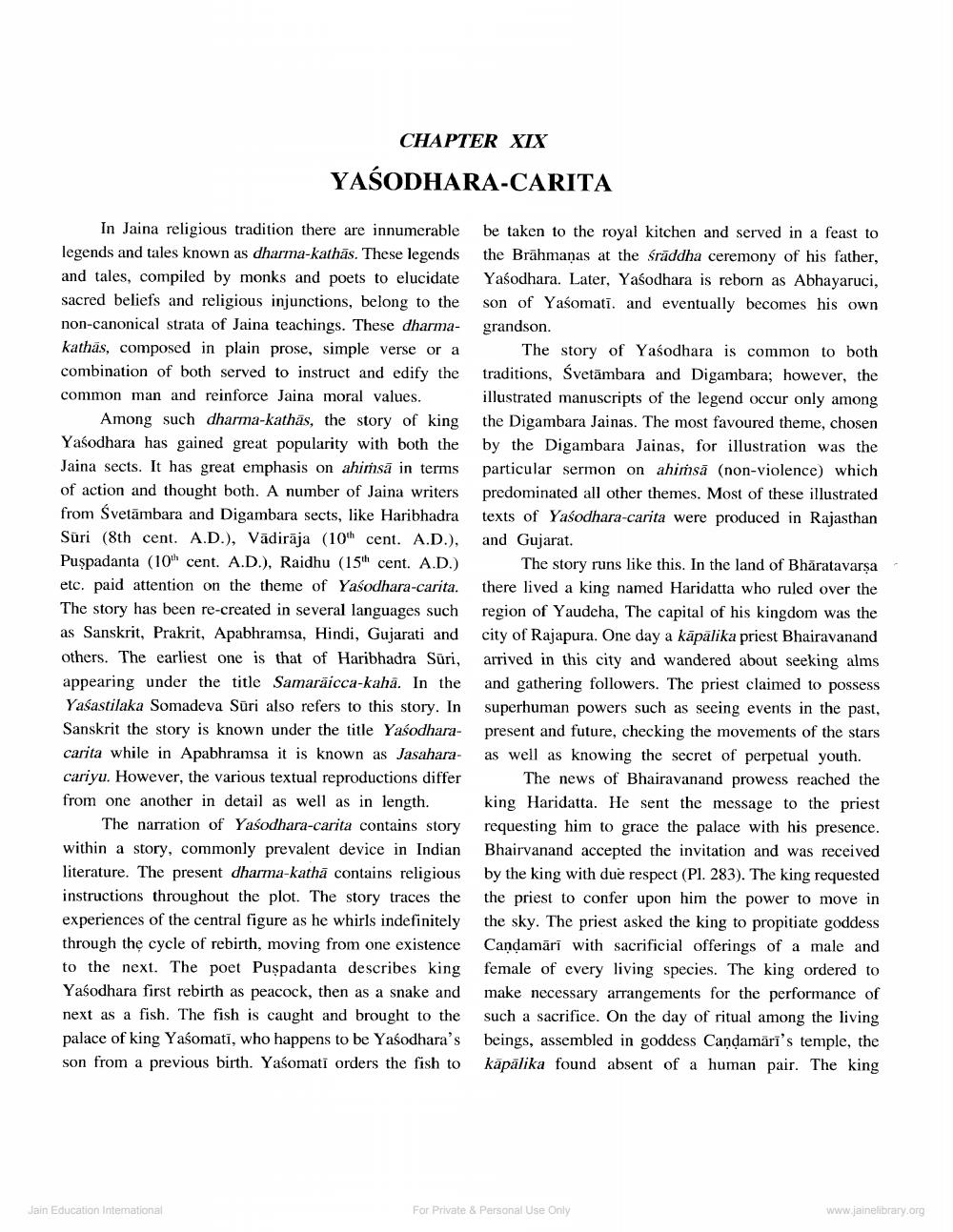________________
CHAPTER XIX YAŚODHARA-CARITA
In Jaina religious tradition there are innumerable legends and tales known as dharma-kathās. These legends and tales, compiled by monks and poets to elucidate sacred beliefs and religious injunctions, belong to the non-canonical strata of Jaina teachings. These dharma- kathās, composed in plain prose, simple verse or a combination of both served to instruct and edify the common man and reinforce Jaina moral values.
Among such dharma-kathäs, the story of king Yasodhara has gained great popularity with both the Jaina sects. It has great emphasis on ahimsă in terms of action and thought both. A number of Jaina writers from Svetambara and Digambara sects, like Haribhadra Süri (8th cent. A.D.), Vādirāja (10th cent. A.D.), Puşpadanta (10h cent. A.D.), Raidhu (15th cent. A.D.) etc. paid attention on the theme of Yasodhara-carita. The story has been re-created in several languages such as Sanskrit, Prakrit, Apabhramsa, Hindi, Gujarati and others. The earliest one is that of Haribhadra Sūri, appearing under the title Samarāicca-kahā. In the Yaśastilaka Somadeva Sūri also refers to this story. In Sanskrit the story is known under the title Yaśodhara- carita while in Apabhramsa it is known as Jasahara- cariyu. However, the various textual reproductions differ from one another in detail as well as in length.
The narration of Yasodhara-carita contains story within a story, commonly prevalent device in Indian literature. The present dharma-kathă contains religious instructions throughout the plot. The story traces the experiences of the central figure as he whirls indefinitely through the cycle of rebirth, moving from one existence to the next. The poet Puspadanta describes king Yasodhara first rebirth as peacock, then as a snake and next as a fish. The fish is caught and brought to the palace of king Yasomatī, who happens to be Yasodhara's son from a previous birth. Yašomati orders the fish to
be taken to the royal kitchen and served in a feast to the Brāhmaṇas at the śrāddha ceremony of his father, Yasodhara. Later, Yaśodhara is reborn as Abhayaruci, son of Yaśomati, and eventually becomes his own grandson.
The story of Yaśodhara is common to both traditions, Svetāmbara and Digambara; however, the illustrated manuscripts of the legend occur only among the Digambara Jainas. The most favoured theme, chosen by the Digambara Jainas, for illustration was the particular sermon on ahiṁsā (non-violence) which predominated all other themes. Most of these illustrated texts of Yaśodhara-carita were produced in Rajasthan and Gujarat.
The story runs like this. In the land of Bhāratavarşa there lived a king named Haridatta who ruled over the region of Yaudeha, The capital of his kingdom was the city of Rajapura. One day a kāpālika priest Bhairavanand arrived in this city and wandered about seeking alms and gathering followers. The priest claimed to possess superhuman powers such as seeing events in the past, present and future, checking the movements of the stars as well as knowing the secret of perpetual youth.
The news of Bhairavanand prowess reached the king Haridatta. He sent the message to the priest requesting him to grace the palace with his presence. Bhairvanand accepted the invitation and was received by the king with due respect (Pl. 283). The king requested the priest to confer upon him the power to move in the sky. The priest asked the king to propitiate goddess Candamārī with sacrificial offerings of a male and female of every living species. The king ordered to make necessary arrangements for the performance of such a sacrifice. On the day of ritual among the living beings, assembled in goddess Candamäri's temple, the kāpālika found absent of a human pair. The king
Jain Education Intemational
For Private & Personal Use Only
www.jainelibrary.org




